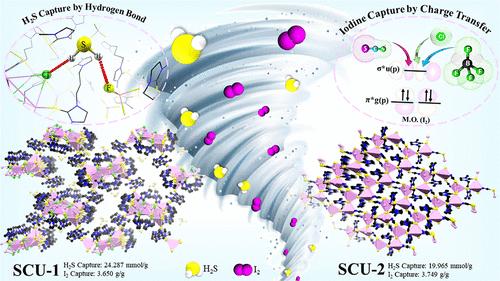两种具有有趣拓扑结构的水稳定银硫mof:高性能H2S吸附和破纪录的碘吸收
IF 4.7
2区 化学
Q1 CHEMISTRY, INORGANIC & NUCLEAR
引用次数: 0
摘要
硫基配位聚合物获得了广泛关注,但构建三维硫基网络仍然具有挑战性。本研究提出了两种新型的三维水稳定银硫mof: {[Ag6Cl2(L3)5][BF4]4}n(cu -1)和[AgSCN(L3)]n(cu -2)。用支管法合成了单晶,x射线晶体学显示了su -1的大阳离子骨架,每个细胞有193个原子,体积为~ 10,000 Å3,孔隙率为15.1%。SCU-2结构简单,孔隙率为5.9%。利用强银硫亲和性和甲巯咪唑基配体的吸碘潜力,研究了SCU-1和SCU-2的吸碘能力,分别达到了3.650 g/g和3.749 g/g,为除碘树立了新的标杆。此外,还首次探索了这些框架对H2S的吸附潜力。SCU-1的富电子位置为bf4和Cl -,其H2S吸附能(Eads = - 45.0 kJ mol-1)高于SCU-2 (Eads = - 39.0 kJ mol-1),其中硫氰酸盐作为富电子成分。模拟结果与实验数据吻合良好,突出了该框架在气体吸附应用方面的潜力。这项工作推进了用于环境修复的硫基mof的设计,特别是在碘和H2S捕获方面。本文章由计算机程序翻译,如有差异,请以英文原文为准。

Two Water-Stable Silver–Sulfur MOFs with Interesting Topology: High-Performance H2S Adsorption and Record-Breaking Iodine Uptake
Sulfur-based coordination polymers have gained significant attention, yet constructing 3D sulfur-based networks remains challenging. This study presents two novel 3D water-stable silver–sulfur MOFs: {[Ag6Cl2(L3)5][BF4]4}n(SCU-1) and [AgSCN(L3)]n(SCU-2). Single crystals were synthesized using the branched tube method, and X-ray crystallography revealed SCU-1’s large cationic framework with 193 atoms per unit cell and a volume of ∼10,000 Å3, exhibiting 15.1% porosity. SCU-2, with a simpler structure, showed 5.9% porosity. Leveraging the strong silver–sulfur affinity and the methimazole-based ligands’ potential for iodine uptake, the iodine adsorption capabilities of SCU-1 and SCU-2 were investigated, revealing remarkable uptake capacities of 3.650 g/g and 3.749 g/g, respectively, setting a new benchmark for iodine removal. Additionally, the H2S adsorption potential of these frameworks was explored for the first time. SCU-1, with BF4–and Cl– as electron-rich sites, exhibited a higher H2S adsorption energy (Eads = −45.0 kJ mol–1) compared to SCU-2 (Eads = −39.0 kJ mol–1), where thiocyanate serves as the electron-rich component. Simulations aligned well with experimental data, highlighting the frameworks’ potential for gas adsorption applications. This work advances the design of sulfur-based MOFs for environmental remediation, particularly in iodine and H2S capture.
求助全文
通过发布文献求助,成功后即可免费获取论文全文。
去求助
来源期刊

Inorganic Chemistry
化学-无机化学与核化学
CiteScore
7.60
自引率
13.00%
发文量
1960
审稿时长
1.9 months
期刊介绍:
Inorganic Chemistry publishes fundamental studies in all phases of inorganic chemistry. Coverage includes experimental and theoretical reports on quantitative studies of structure and thermodynamics, kinetics, mechanisms of inorganic reactions, bioinorganic chemistry, and relevant aspects of organometallic chemistry, solid-state phenomena, and chemical bonding theory. Emphasis is placed on the synthesis, structure, thermodynamics, reactivity, spectroscopy, and bonding properties of significant new and known compounds.
 求助内容:
求助内容: 应助结果提醒方式:
应助结果提醒方式:


